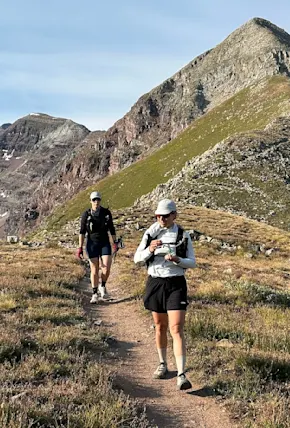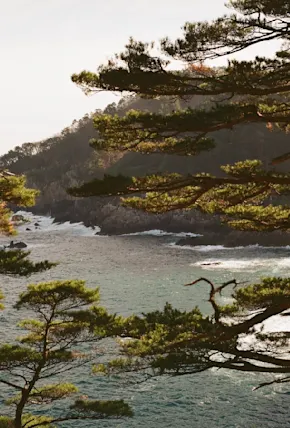Fall Foliage & Local Harvests
By November, the fall colors set the region ablaze, with Japanese larch (karamatsu) trees lining the farm fields and mountains turning a striking golden yellow. Walking between bright green sugar beet fields and the glowing larch forests sometimes felt more like the English countryside than northern Japan. A local farmer I passed one day clarified that the towering piles of rocks I kept seeing next to the fields were actually mounds of sugar beets drying before they'd be sent off and processed into sugar.
Hiking the HET in the Winter
It's inadvisable to hike the full length of the HET once winter sets in since road closures and snow make travel difficult—somethign I was constantly reminded of by the red and white arrows floating above the region's roads, which show snow plows where the curb is when it's buried. The official HET recommended months are May to October. Section hikes and national park visits remain entirely possible though, and winter has its own draws, like walking on the drift ice that forms along the coastline near the northern section of the HET.
Highlights of the Hokkaido East Trail
While I didn’t get a chance to walk the full length of the trail in a single journey, I did get to see most of the major stops. These are a few of the locations I found most interesting.
Akan-Mashu National Park
At the center of the HET, Akan-Mashu National Park is a land of calderas, onsen villages, and primeval forests. You can find the Mashu-Kussharo Trail (MKT) here as well, a 62.5-kilometer (38-mile) regional hiking route that has now been incorporated into the HET. The Mashu-Kussharo Trail runs along the rim of Lake Kussharo's caldera and through groves of dwarf bamboo, which carpet the low-laying mountains in the area. Walking the MKT, I was able to see both the caldera in its entirety and as far as the Pacific Ocean, a unique sight you can’t experience anywhere else in Japan. Two other regional trails in the area that the HET has incorporated are the 25-kilometer Kushharo Caldera Trail (KCT) and the 43-kilometer Uramashu Outer Rim and Kaminoko Pond Trail, both of which are excellent trail running routes.
Another highlight is the short Tsutsujigahara Nature Trail, where Labrador tea shrubs thrive in the acidic volcanic soil. We walked a portion of this trail from the Kawayu Nature Center to Mt. Io, an active volcano with yellow tinted sulfur geysers dotting the mountainside.
Because of the geothermal activity, hot spring villages like Kawayu Onsen and Akanko Onsen are popular nearby. Akanko is especially worth visiting, as it's one of the few places where visitors can experience Ainu cultural museums dedicated to the indigenous people of Hokkaido. It's worth checking out, even if it is a little touristy. Keep an eye out for the bizarre green algae spheres, called marimo, found in the nearby lake.



















